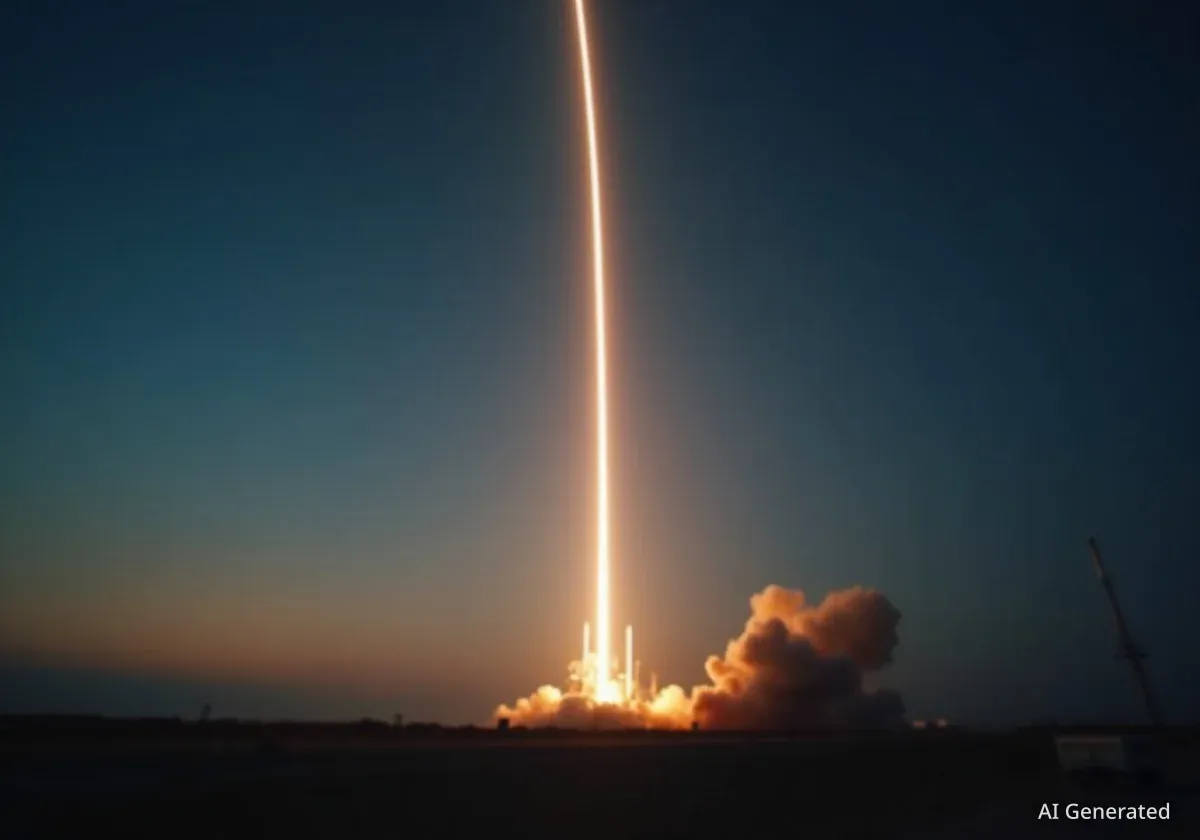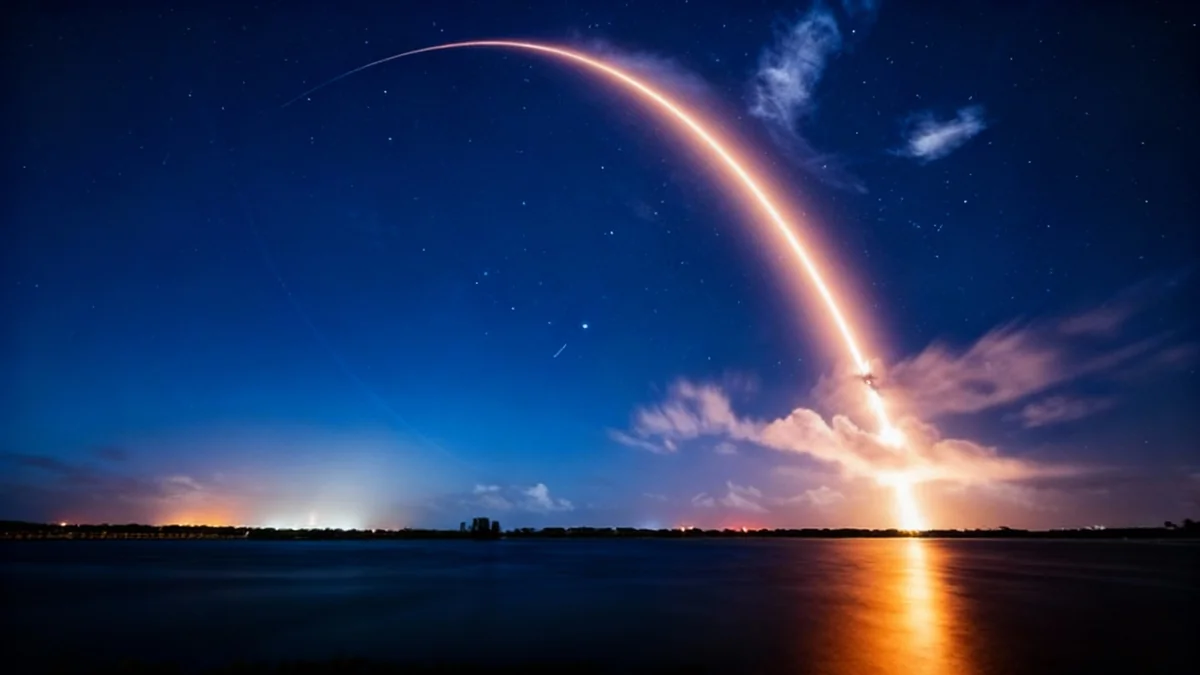SpaceX successfully launched another group of its Starlink internet satellites into low Earth orbit early Thursday morning. The mission, utilizing a Falcon 9 rocket, lifted off from Cape Canaveral Space Force Station in Florida, adding 28 more satellites to the company's growing global broadband constellation.
Key Takeaways
- Mission: A Falcon 9 rocket carried 28 Starlink satellites into orbit.
- Launch Time & Location: The launch occurred at 5:27 a.m. on Thursday from Cape Canaveral Space Force Station, Florida.
- Booster Recovery: The first stage of the Falcon 9 rocket successfully landed on a droneship stationed in the Atlantic Ocean for future reuse.
- Purpose: The mission continues the expansion of the Starlink satellite network, designed to provide high-speed internet access globally.
Pre-Dawn Liftoff from the Space Coast
Florida's Space Coast was illuminated before sunrise on Thursday by the launch of a SpaceX Falcon 9 rocket. The mission began precisely at 5:27 a.m. from its launch pad at the Cape Canaveral Space Force Station. The pre-dawn timing provided a spectacular visual display as the rocket ascended through the atmosphere.
The primary payload for this flight consisted of 28 Starlink satellites. These units were successfully deployed into their designated low Earth orbit following the separation from the rocket's second stage. This deployment marks another step in SpaceX's ambitious plan to build out its satellite internet service.
The Falcon 9's Reusable First Stage
A critical phase of the mission involved the recovery of the Falcon 9's first-stage booster. Shortly after separating from the second stage, the booster performed a series of engine burns to guide itself back through Earth's atmosphere. It executed a precise landing on one of SpaceX's autonomous droneships positioned in the Atlantic Ocean.
This successful recovery is a key component of SpaceX's operational strategy. By reusing its rocket boosters, the company significantly reduces the cost of launching payloads into space, enabling a higher frequency of flights for both its own projects and commercial clients.
Booster Reusability by the Numbers
SpaceX's focus on reusability has transformed the launch industry. Some individual Falcon 9 boosters have flown more than 20 times, demonstrating the reliability and cost-effectiveness of the technology. This approach has allowed the company to maintain a rapid launch schedule.
Expanding the Starlink Network
The 28 satellites from this launch will join the thousands already in orbit as part of the Starlink constellation. The project's goal is to provide reliable, high-speed, low-latency internet access to underserved and remote areas across the globe. The network is already active in numerous countries, offering an alternative to traditional ground-based internet infrastructure.
Each Starlink launch adds more capacity and coverage to the network. As more satellites become operational, the service is expected to improve in terms of speed, reliability, and the number of users it can support simultaneously. SpaceX regularly launches batches of satellites to continue this expansion and to replace older units.
What is a Satellite Constellation?
A satellite constellation is a group of artificial satellites working together as a system. Unlike a single satellite, a constellation can provide permanent global or near-global coverage. For services like Starlink, this means that as one satellite moves out of view, another moves into position to maintain a continuous connection for users on the ground.
SpaceX's Dominance in Launch Services
This mission underscores SpaceX's high launch cadence, which has become a defining feature of the modern space industry. The company frequently conducts multiple launches per month, a pace made possible by its reusable rocket technology and streamlined operations at its launch facilities in Florida and California.
"Watch Falcon 9 launch 28 @Starlink satellites to orbit from Florida," the company announced in a statement accompanying the live broadcast of the mission.
The consistent schedule of Starlink launches serves a dual purpose. It not only builds out the company's own internet service but also provides a steady stream of flight data, allowing engineers to refine the performance and reliability of the Falcon 9 vehicle. This continuous improvement benefits all of SpaceX's customers, including commercial satellite operators and government agencies like NASA.
Future Implications for Global Connectivity
The ongoing expansion of the Starlink network has significant implications for global communication. Potential benefits include:
- Connecting Rural Areas: Providing internet access to communities where traditional broadband is unavailable or prohibitively expensive.
- Disaster Response: Offering a vital communication link for emergency services when ground infrastructure is damaged.
- Mobility: Enabling high-speed internet on moving platforms like airplanes, ships, and RVs.
As the constellation grows, so does the discussion around its impact. Topics include managing space debris in low Earth orbit and mitigating the effect of satellite brightness on astronomical observations. These are challenges the entire space industry is working to address as more large-scale constellations are deployed.
With this successful launch, SpaceX continues to solidify its role as a leader in both launch services and satellite operations, pushing forward with its vision of a globally connected world.





